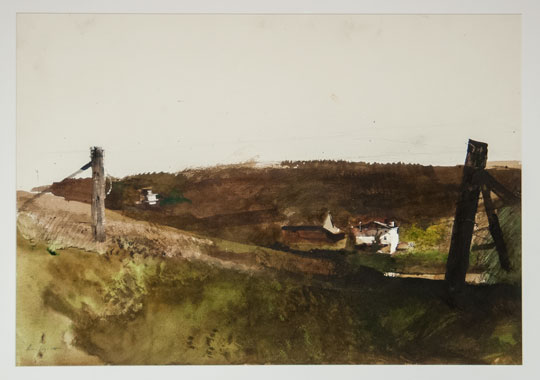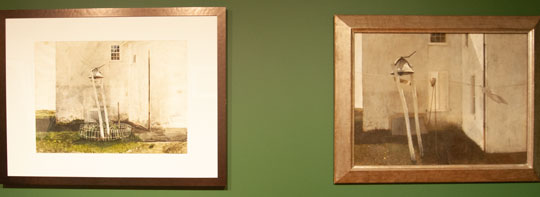There’s nothing new for the Brandywine River Museum of Art to have an exhibit of Andrew Wyeth paintings but the new exhibit, Andrew Wyeth: Home Places, has fired the imagination of a new curator.
Will Coleman is the museum’s inaugural Wyeth Foundation Curator and Director of the Andrew and Betsy Wyeth Study Center.

“This is the first project of my watch,” Coleman said acknowledging he only started at the museum in mid-October. “It’s a celebration of this exciting new partnership between the Brandywine and the Wyeth Foundation for American Arts.”
The exhibit contains 50 images drawn from more than 7,000 of Wyeth’s works, some of which have never been shown publicly. At least one of the pieces, The Miller’s Son, was painted in 1964 when Wyeth was only 17. True to the exhibit’s name, the scene is of a young boy by the stream at Brinton’s Mill, the property that later became the Wyeth’s home. Of interest to some is that the boy looks very much like a young Andrew Wyeth as once painted by his father, N.C. Wyeth.
All the pieces in the exhibit were collected by Wyeth’s wife, the late Betsy James Wyeth., Coleman said.
“She was the real power behind the throne, the creative force who documented his collection, studied it meticulously and preserved it for our enjoyment here. There are a lot of stories in this collection.”
As the name of the exhibit implies, the works feature homes and properties that most people have seen before in Chadds Ford — the Kuerner Farm, Painter’s Folly, Brinton’s Mill, Big Bend, and the Barns Brinton House — but in a way that most people have not seen. An example is an untitled watercolor color from 1967, a landscape showing both the Kuerner Farm and Painter’s Folly in the same image.
Another piece, rather twin pieces with both showing the same image of the rear of a building and a bell supported by two poles, but one shows a clothesline with laundry drying in the breeze, and the other with a small fence. Together they reflect more of Wyeth’s approach. One is watercolor and the other is tempera. According to Coleman, Wyeth had said he preferred the watercolor and wished he had done only that version.
Coleman sees Wyeth as an example of an artist who “inhabits a particular landscape and comes to know it intimately over an extended time.” He called him an “unusual and original artist who deeply immersed himself in this particular place.”
He said Wyeth was unapologetic about his work and his approach to it, about not going along with the flow of other contemporary artists of his time.
“His work was shocking and bold, and celebrated the patterns and geometry of the buildings,” Coleman said. “The objects in this show range from the really minute realism to really broad and abstract creative practice. These same buildings offer all these possibilities for this particular American original, Andrew Wyeth,” who he referred to as an artist out of his own time.
He said that Wyeth doesn’t fit into any usual categories.

“He’s unusually attuned to history…He’s especially fascinated with the Battle of Brandywine, this revolutionary history of the region, and all the old buildings that were here at the time of the battle. And he had this incredible imagination. You can picture him walking these fields and seeing Red Coats in the trees…which is one way of time, but he’s also ahead of his time. He’s looking forward, he’s making art that some contemporaries weren’t ready [for]. He’s working in the time of Jackson Pollock and geometric abstraction. He’s going his own way.”
Coleman isn’t finished bringing to light what he’s learned about the Wyeths. He said he’s discussing another Wyeth-related project, this one keying on Betsy Wyeth and her influences. Not only did she help catalog and title Andy’s paintings, but she also bought, designed, and renovated numerous buildings and created “inspirational environments” that her husband painted.
“We’re in the very early stages and will require a lot of collaboration from colleagues up in Maine, so I have meetings coming up in two weeks to kick off the conversations. It’s still multiple years away. It isn’t even titled but I imagine a project that celebrates the creative life of Betsy James Wyeth,” he said.
Andrew Wyeth: Home Place runs through July 13.
About Rich Schwartzman
Rich Schwartzman has been reporting on events in the greater Chadds Ford area since September 2001 when he became the founding editor of The Chadds Ford Post. In April 2009 he became managing editor of ChaddsFordLive. He is also an award-winning photographer.




Comments